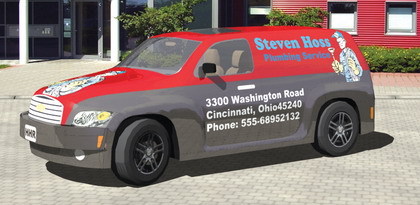One has to admire the diligence required of early-generation, vehicle-graphics providers. Their jobs likely entailed countless measurements to verify their designs gibed with a vehicular body type. However, admiration for this work ethic shouldn’t necessarily translate into eschewing modern resources that enhance a signmaker’s ability to provide quality vehicle graphics.
Software programs with computer templates represent one such tool. Through vector-art or digital-image files, these programs offer renderings that allow service providers a conceptual starting point from which to build and scale their graphics.
MR Clipart , a Hanover, Germany-based, vehicle-template provider, began producing vehicle templates on CD in 1991 because Digital Designware Inc.'s owners, Dirk Moebes and Manfred Ratacjzak, believed available clipart was inadequate. In 2004, the company adapted to a DVD format because CDs lacked sufficient memory space to accommodate the more than 20,000 vehicle templates the company had accumulated.
Key product enhancements have included a photo-download area, which eases image importation, and a 3-D design program that facilitates mastering vehicle contours and enhancing presentations providers make to would-be customers. According to Moebes, the one potential error is scaling the design incorrectly – the templates are created at 1:20 scale.
To develop the files, MR Clipart obtains product files from car manufacturers when possible; however, few have allowed such access. Alternatively, the company takes hundreds of photos, measures vehicles by hand, develops a rough template and, finally, fine-tunes its work.
Advertisement
“We create vector-file templates, because they’re much smaller and more efficient to use than large bitmap files during the design process,” Moebes said. “They’re more accurate than distorted, digital-picture images.”
Earlier this year, MR Clipart and Digital Auto Library, a Greeley, ON, Canada-based company that produces similar products, joined forces to develop Digital Designware, which, according to Moebes, synthesizes the best characteristics of both companies’ template systems.
Sergio DeSoto, who developed the Bad Wrap, a template program now offered exclusively through sign-supply distributor Fellers(Tulsa, OK), began his career as a vehicle-graphics provider before he sold his shop and used his process to develop the software.
“I thought the design process needed to be simplified,” DeSoto said. “The more time spent on design, the lesser the print runs, and the less money the shop makes.”
The Bad Wrap currently offers approximately 400 car models (the most exotic being the Ferrari Testarossa) and roughly 3,700 available model years. The system incorporates scaled TIFF image-file templates, which DeSoto said offer depth and perspective that vector art can’t, based on predetermined measurements.
Based on his experience, he said the Chevrolet HHR takes the crown as the most difficult vehicle to wrap because of its unusual bumper contours and numerous, deep curves, whereas PT Cruisers, VW Bugs and most standard vans offer simple surfaces with more shallow curves.
Advertisement
DeSoto said shops commonly err by not allowing enough image bleed – he recommends 3 in. of material in excess of the car’s dimensions in all directions – and creating designs that incorporate excessive or poorly placed texts. Also, he recommends that Bad Wrap users operate computers with at least 4GB of available RAM and regularly calibrate monitors and printers to ensure color accuracy.
Although these programs can save time and labor, service provders should remember the “measure twice, change once” maxim and take their own measurements – minor vehicle imperfections, which could parlay into major headaches, are always possible.


 Tip Sheet1 week ago
Tip Sheet1 week ago
 Photo Gallery2 days ago
Photo Gallery2 days ago
 Ask Signs of the Times4 days ago
Ask Signs of the Times4 days ago
 Real Deal1 week ago
Real Deal1 week ago
 Benchmarks6 days ago
Benchmarks6 days ago
 Editor's Note2 weeks ago
Editor's Note2 weeks ago
 Women in Signs1 week ago
Women in Signs1 week ago
 Photo Gallery1 week ago
Photo Gallery1 week ago
















